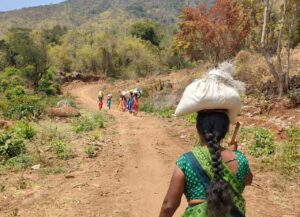With a budget of ₹1,005 crore sourced from PM-JANMAN, MGNREGS, and sub-plan funds of the state government, the 'Adavi Thalli Bata' programme promises to lay 1,069 km of roads, connecting 625 remote tribal habitations.
Published Aug 12, 2025 | 9:00 AM ⚊ Updated Aug 12, 2025 | 9:00 AM

The tribals rely on dolis—makeshift bamboo stretchers carried by villagers—to transport patients on rugged trails. (File pic/South First)
Synopsis: In many agency areas, roads are no more than mud tracks in the monsoon or rough gravel trails. In the Alluri Sitarama Raja district, more than 600 tribal villages remain without road connectivity. It forces residents to trek long distances to access healthcare, markets, or schools. The absence of bridges and drainage isolates entire habitations for days whenever there is a downpour.
For decades, tribal communities across Andhra Pradesh have lived with treacherous terrains and seasonal isolation, which cut them off from basic services.
But the state government’s ‘Adavi Thalli Bata’ initiative—currently being rolled out under the Prime Minister’s Janjati Adivasi Nyaya Maha Abhiyan (PM-JANMAN) scheme—seeks to link the remotest habitations with all-weather roads and essential infrastructure, if it goes as planned.
The Centre has already released ₹555.6 crore for the works under PM-JANMAN. The scheme appears to be a good beginning.
At a review meeting with officials of the Panchayat Raj and Rural Development Department on Sunday, 10 August, Deputy Chief Minister Pawan Kalyan asked them to engage with local communities so they understand the project’s goals.

Roads are mostly mud tracks in the monsoon or rough gravel trails. (File pic/South First)
“People must know that we want to create doli-free habitations,” he said. “Their cooperation and encouragement will help us deliver faster.”
“We are building roads in areas that have never had connectivity before. If challenges arise, they must be addressed strategically. For some villages, this will be the first time in history that they will have a motorable road. This is a turning point. The goal is to make tribal areas ‘doli-free’ for the first time since Independence.”
In Andhra Pradesh, as per the 2011 census, the tribal population was 2,739,919, which constituted 5.53% of the state’s total population. A significant portion of this population, approximately 51.14%, lives in the scheduled areas of the Eastern Ghats, which are part of the Tribal Sub-Plan areas. These areas include the Integrated Tribal Development Agencies of Paderu (Visakhapatnam), Parvathipuram (Vizianagaram), Seethampeta (Srikakulam), and Rampachodavaram (East Godavari).
In many places, roads are mostly mud tracks in the monsoon or rough gravel trails. In the Alluri Sitarama Raja (ASR) district alone, for instance, more than 600 tribal villages remain without road connectivity. It forces residents to trek long distances to access healthcare, markets, or schools. The absence of bridges and drainage isolates entire habitations for days whenever there is a downpour.
Health experts said the lack of connectivity is more than an inconvenience. It is a matter of life and death. Ambulances cannot reach the interiors. The tribals rely on dolis—makeshift bamboo stretchers carried by villagers—to transport patients on rugged trails.
In March 2023, for instance, a 20-year-old pregnant woman, Sukuru Lakshmi, was carried on a doli for four km from Rachakilam village to Gummanti in the ASR district when she went into labour. From there, she was shifted to Pinnakota hospital in an ambulance. Later, she was taken to the Kotapadu area hospital in Anakapalle district because there was no doctor at that time. Her relatives then took her to Visakhapatnam and admitted her to King George Hospital (KGH) in Visakhapatnam, which was indicative of the pathetic road infrastructure and lack of medical care anywhere nearby.
Economic hardship deepens the problem. Farmers growing coffee, turmeric, and millets face post-harvest losses because their produce cannot reach markets in time. Children’s education also suffers as schools are often many kilometers away without reliable transport. Even basic amenities like electricity and drinking water remain erratic in interior areas. Landslides during monsoons can sever already fragile links, halting food supplies and cutting off government outreach.
Against this backdrop, ‘Adavi Thalli Bata’ is being looked at with hope. With a budget of ₹1,005 crore sourced from PM-JANMAN, MGNREGS, and sub-plan funds of the state government, the programme promises to lay 1,069 km of roads, connecting 625 remote tribal habitations.
The plan includes black-topping existing tracks, building entirely new stretches, and adding essential features like drains, schools, health centers, and drinking water facilities. In the ASR district alone, a ₹1,050 crore package is earmarked to uplift the Particularly Vulnerable Tribal Groups (PVTGs) such as the Kondhs and Savaras.
Officials said that of the 128 roads planned through reserved forest areas, 98 have received forest clearances. Work is in progress on 186 stretches, with 20 more in the tendering stage. However, challenges remain—blasting boulders for hilltop routes takes time, steep gradients require special engineering measures, and persistent rains slow down activity.
With a total state allocation of ₹7,557 crore for tribal welfare this year, ‘Adavi Thalli Bata’ stands as the flagship of Andhra Pradesh’s renewed push for better road infrastructure for the most neglected segment of the population. But its true success will be measured when it is implemented in full, obviating the need for the tribals to use dolis on muddy tracks.
(Edited by Majnu Babu).
